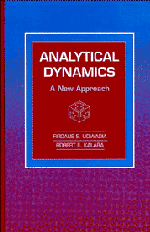Book contents
8 - CONNECTIONS AMONG DIFFERENT APPROACHES
Published online by Cambridge University Press: 22 March 2010
Summary
In the last seven chapters we have developed some of the basic concepts of analytical mechanics and have moved along various fundamental threads of thought, among them Gauss's principle and the basic equation (principle) of analytical mechanics. In the previous chapter we came full circle, as it were, by deriving Gauss's principle from the basic principle of analytical mechanics. We then used it to obtain, in a straightforward manner, the fundamental equation of analytical mechanics in Lagrangian coordinates.
In this, our last chapter, we shall attempt to further deepen our understanding by looking at alternative formulations of the problem of constrained motion and by developing the various interconnections between them, thereby weaving the various threads that we had previously laid out into the fabric that is analytical dynamics. This, we hope, will provide the reader with a more holistic picture of the subject.
We shall begin with some of the subtler ideas related to the fundamental equation, and provide the general form of the fundamental equation. Then we will move on to the Lagrange multiplier method and show its close connection to the fundamental equation and to the basic principle of analytical mechanics. The general form of the Lagrange multiplier vector will be obtained. We shall also develop the equations of motion through the direct use of the basic principle of analytical mechanics. This approach re-emphasizes the importance of linear algebra even when considering highly nonlinear mechanical systems.
- Type
- Chapter
- Information
- Analytical DynamicsA New Approach, pp. 236 - 256Publisher: Cambridge University PressPrint publication year: 1996

